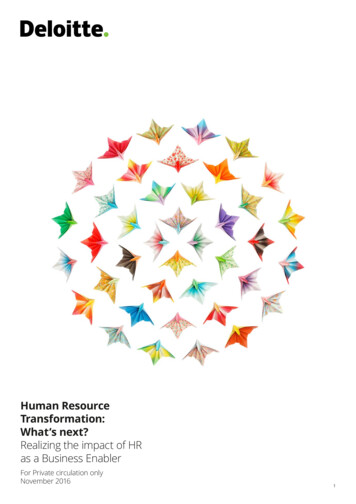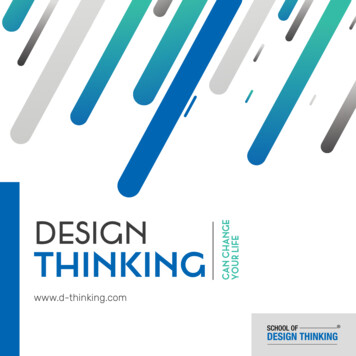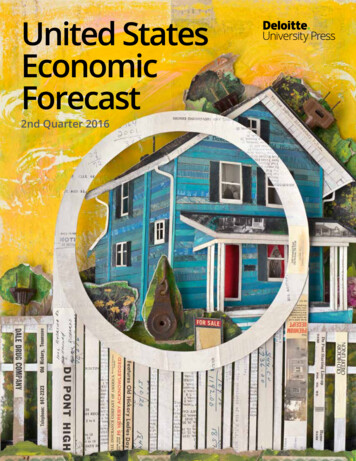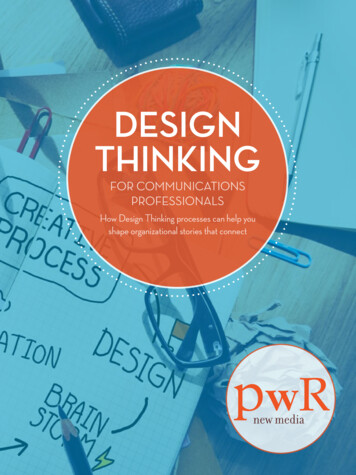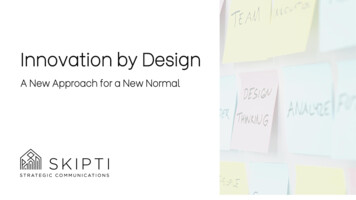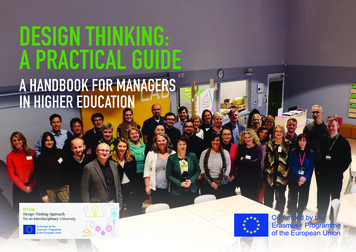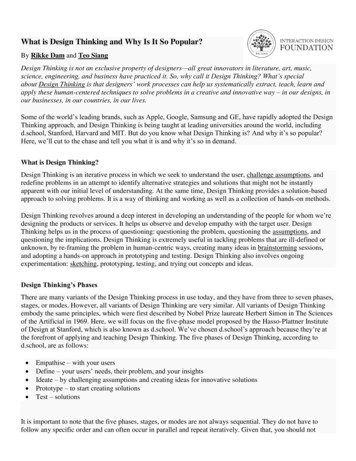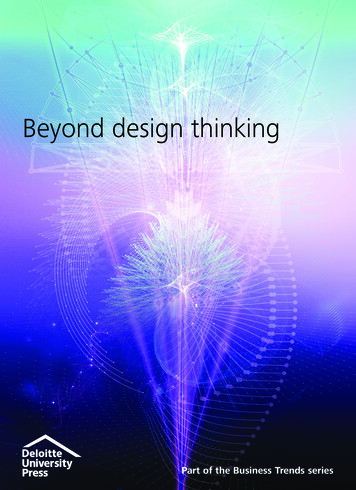
Transcription
Beyond design thinkingPart of the Business Trends series
Business ecosystems come of age
Beyond design thinkingBeyond design thinkingBy Larry KeeleyOverviewNOW that many business schools and largecorporations have grown enamored of“design thinking” perhaps it’s an importantmoment to examine this trend critically.1 Inthis brief trend report the goal is to describewhy design is in ascendance, with an emphasison how to make it as powerful, effective, andtransformational as it deserves to be.In popular constructs, design thinkingapproaches a problem to be solved from theopposite direction typically taken by analysts.It begins by imagining a solution that doesnot yet exist, and outlines a pathway to realizeit—instead of beginning with an assessmentof today’s problems and seeking corrections tothem. At its heart, design thinking seems selfevidently useful. Generate ideas. Build prototypes. Try many things. Build narratives aboutthem. Test everything. Do more of what works.Show a bias for action. Shoot for the moon.Or maybe even Mars. At that level, who couldpossibly disagree?But often proponents of design thinkingtake it further. They make it a panacea. Theythink it “fixes” the dry, overly rational planningapproaches that firms use to optimize theirofferings around predetermined and deeplyanalyzed market segments. In this assertion,the fans of design thinking are half right:Conventional approaches to planning are overdue for reinvention. It’s the other half wheretheir enthusiasm can be overdone. In the way“design thinking” is popularly described anddelivered, it is too superficial to truly deliver onsuch grandiose expectations.Design thinking without deepanalysis and synthesis can bereckless. Leading companiesare seeking to do bothrecursively and in integratednew ways to managecomplexity, derive insights,and catalyze innovation infast-changing ecosystems.Ecosystems are dynamicand co-evolving communitiesof diverse actors who createnew value throughincreasingly productive andsophisticated models ofboth collaborationand competition.Read more about our view of businessecosystems in the Introduction.What’s behind this trendLast year the Design Management Instituterigorously selected 15 design-centric publiclytraded companies. Those that made the cutinclude Apple Inc., Coca-Cola, Ford, IBM,Intuit, Procter & Gamble, Starbucks, Nike, andothers. These companies, which use designstrategically and integrate it through theirbusiness processes, tend to grow faster andhave higher margins than their competitors—the identified companies’ returns were 2.28times larger than the S&P’s returns over theprevious decade.21
Business ecosystems come of ageTHE TREND IN A NUTSHELL“Design thinking” has been increasingly embraced by the world of business and business education over the lastdecade. During a time of intense change, this is a positive development. It helps firms develop the courage anduse tradecraft that moves beyond analysis to embrace synthesis as well. This is part of what it takes to help firmscommit to building something bold and newsworthy, instead of only seeking the tactics needed to better sell whatis already known.What many people are missingToo often advocates of “design” overreach, regarding it as an elixir that can somehow transform conservativecompanies into creative ones. In the most egregious cases, advocates suggest design thinking can somehowreplace nearly all other forms of analysis, planning, and strategy.What great leaders should know and do nowThe power of design is real and increasingly important. It can help firms build breakthroughs and change industries,but it has to be balanced and integrated with other skills and capabilities. This is especially true now because thereis a parallel revolution in how to get new insights from analytic techniques—and no one should ever jump rightinto innovating without first producing some set of profound insights first that can be the basis for an innovationteam to do the hard work of building a breakthrough.Put simply, analysis without synthesis is predictable and commonplace. Design thinking without deep analysis isreckless. The savvy leader now seeks to do both, recursively, in integrated, even dazzling new ways.Of course, any good academic would notethat these companies are likely to be good atmany things besides design, so this correlationis not causation. A deeper piece of researchwas led by my colleague Brian Quinn as a partof our work to author Ten Types of Innovation,where he was able to definitively establishthat among 138 publicly traded companiesgenerally agreed by analysts to get a stockpremium for innovation, there is a very strongcorrelation between the number of types ofinnovation they use in their most valuableplatforms and their stock performance abovethe S&P.3 We conclude that more sophisticateddesign goals, when executed effectively, yieldbigger payoffs.Used effectively, design and designers trulydo have the power to transform nearly everything: concepts, brands, categories, markets,technologies, materials, logistics systems,experiences, industries, even governments.There are structural reasons why design isnow enjoying a new and deserved renaissance.Stripped to the bedrock, here are the specificskills shared by great designers and gooddesign teams.2Designers: Conceive and make stuff Make things, places, andmessages distinctive Empathize with people in situations Stand in the future and prototype abetter world Imagine ideal usage experiences Sense and value what is new Grapple with ambiguity more comfortablythan most Systematically test and iterate conceptsuntil they get them right Simplify and clarify information Dramatically affect preference and valueScan this list carefully. You may discoverthat each of these qualities is rare, valuable,and particularly relevant when change is in theworks or in the wind. Next, add the possibilitythat we humans now live in the greatest timeof change in the history of our species and youimmediately can sense why the value of designand designers is ascendant.
Beyond design thinkingNotice that none of the rationale so farresorts to market arguments. The argument isnot that you simply must design your smartphone, insurance plan, office chair, coffeemachine, or hotel well for it to have a chanceto be appealing to customers who have manychoices in modern, heavily contested markets.That should be obvious. The point here is actually more important and subtler: In the worldright now we are changing the rate of change.So it’s incredibly valuable to have the skill toimagine a better world,make it tangible, buildnarratives about it, andthen work through thedozens of obstaclesthat anything new facesthroughout its development. And all the moreso in a world whereconnectivity, collaboration, interdependence,and user engagement allconverge to build modern integrated ecosystems where we formerlythought of industries.So with all the change in the wind it wouldbe great to simply pile on the popular trendand say that all companies would be betteroff if they used more design thinking. Sadlythough, in the simple ways these ideas arenow routinely described and taught, designthinking tends to both over-promise andunder-deliver.Great designers have the skill to build gossamer cathedrals: beautiful visions made ofnothing but art techniques, but with the powerto help those of us with little or no imagination to vividly experience a world that doesn’texist yet. When this is done to reimaginesomething valuable, often a single simple storyand a prototype can take the place of hundredsof PowerPoint charts and slides, filled withcomplex arguments. Like a great poker hand,this can be a lay down: Share it with a seniorexecutive team and it immediately gets peopleto respond to a concrete idea. They may love it,hate it, or want more information, but since itis clear and tangible, they do not have to wasteany time trying to imagine it.But is this “design thinking”? Well let’s takeit apart: First, this specific part, the prototypedevelopment where much of the magic lies,is less about thinking than great tradecraftand hand-skills. Well-trained designersand innovators may now have to master asmany as 60 such methods.Used effectively, design and designerstruly do have the power to transformnearly everything: concepts, brands,categories, markets, technologies, materials,logistics systems, experiences, industries,even governments. Second, it should be done inside a teamthat integrates many forms of thought andaction—explicitly using advanced forms ofboth analysis and synthesis. Third, it may take weeks of climbing aconfusion curve before the team has even asmall chance of coming down the other sideto craft something simple and compelling. Fourth, the individuals on a team with thepower to do this kind of work are almostnever all designers, but instead have manydiverse backgrounds and specialized skills.So it’s painful when this incredibly valuable skill is represented as if designers do allthis stuff routinely and reliably. That’s unfairto both designers and to the other professionals who have learned to love and leverage the unique skills of design and designers.The real story is far more important than thissuperficial label.3
Business ecosystems come of ageThe trendStanding in the future: Seeingthe world that is comingTo get a glimpse of at least one way thisfuture world will play out, let’s leave theabstract and go to the specific. Late in 2014a firm located in Los Angeles made wavesby declaring that they have built an entirelynew way to improve how fans watch, or howprofessionals coach and play sports. SecondSpectrum has only been around for a littleover a year at this writing, but their youngteam of 30 people collectively has decades ofexperience in sports, sports analytics, big data,design, computer science, and management.4They also really get the world of data visualization. Their leaders have won multiple awardsat the MIT Sloan Sports Analytics Conferenceand they have conceived of some of the newest advances in “sabermetrics,” the abstruseworld first popularized in Michael Lewis’s bookMoneyball, later made into a popular movie.5To understand how they do this, look at thisphoto of one of their products, taken from theSecond Spectrum website:Figure 1. A Second Spectrum gamehis odds of getting the resulting two pointsare about 45 percent. Alternatively, he couldpass the ball across the court (and over threedefenders!) to his colleague Matt Barnes for athree-point shot, but this would have a lowerchance of success, only 35 percent. Or, hecould pass it to Blake Griffin on his left, withthe worst odds of successfully making thebucket. Highlighted in green is his bestoption: tossing the ball to the right, whereJ. J. Redick has a 43 percent chance of making a three-point shot, which is equivalent interms of point value to a 65 percent chancetwo-pointer. Notice that the software immediately highlights that best option in green, theother three are yellow. In subsequent frames,the software also shows how these options, andtheir corresponding expected values, change asthe play progresses.In general, the Second Spectrum capabilitydistills six distinct capabilities, including anamazing ability to dynamically model “largescale spatiotemporal data” into software toolsthat transform how we can better understand acomplex, fast-moving game.6 As represented bythe icons in figure 2, what they have learned tointegrate is: Massive data sets, so that they can find patterns from past actions Analytic models, so they know what to payattention to and what to track Real-time visualization, so that they areable to pick the moments that matter Close examination of details, so stuff thatmatters is in color and stuff that doesn’tis greySource: Second Spectrum. Reprinted with permission.What you are seeing here is their realtimeability to illustrate how a coach might improvethe playing skills of Chris Paul, the playershown with the ball, highlighted by theirsoftware in bright red. The software shows thatChris could shoot the ball from his currentposition, and using big data, they calculate that4 Graphics overlays that highlight in colorand layer data that is critical in the moment Storytelling methods that help coachescoach, players play, and fans besmarter viewersThe team at Second Spectrum developedthese capabilities in large part because theyloved the ideas and saw them as intellectuallycompelling. Their plan was to develop themfully over the next five to ten years. Of course
Beyond design thinkingFigure 2. Second Spectrum’s six distinct capabilitiesMassivedata nationGraphicsoverlayStorytellingSource: Second Spectrum.they could not have anticipated the fascinating series of events that transpired when SteveBallmer bought the LA Clippers for a reported 2 billion in cash—nearly four times the priorhighest price paid to buy an NBA team.7 ThenBallmer dropped by to visit their LA lab. TheSecond Spectrum team showed their waresand described their five-year plan. Steve,seeing the value in the capabilities, immediately urged them to apply all their capabilities to the Clippers and accelerated theirdevelopmental timetable.8This is what happens when you get innovation right: It transforms entire fields, oftenmuch faster than anyone anticipated. Think ofthe speed with which smartphones changedtelephony, Uber changed the urban taxi market, Airbnb changed the hospitality market,and Twitter changed the ability of repressiveregimes to control how their populations communicated with one another.To fully appreciate what Second Spectrumhas shown us we have to imagine it as the leadedge of a large plow. Imagine a world where wedon’t just use such elegant computational firepower for sports. After all, none of us shouldbe surprised when some of the most advancedprocess innovations are first applied by billionaires, spending their own money, on theirhobbies—typically they can do so very easilyand with no approval committee!But the rest of us should imagine somethingsimilar will be used to help medical teams treatcomplex patient conditions with integratedcare strategies. Or imagine seeing your personal or family finances this way—includingsimplified visual suggestions for the simplestchanges that would make the biggest impactin helping achieve family goals. Or perhapswe use a similar capability to fully understandchanging climate conditions with less ambiguity, more clarity, and absolutely no politicalspin. Capabilities like this should, by all rights,transform nearly every field, from agricultureto education, transportation and logistics,investments and financial operations, weatherprediction, travel and hospitality, politicalcampaigns, or even warfare, whether real orcyber—even those “wars” declared againstpoverty, drugs, extremism, or terror.ImplicationsIntegrated analysis andsynthesis: The new frontierSo is this design thinking? Not really, thoughyou sure couldn’t have 10 percent of thisimpact without effectively using design, especially data visualization methods. An effectiveway to understand what Second Spectrum haspulled off is that they are harnessing many specialized skills, all with elegant integration, sothat their genius ideas fall into the backgroundand they help us regular folks make it easy todo hard things. At a larger level, this illustratesa critical principle of 21st century innovation:Effective innovations today are far more aboutelegant integration of the known than about theprimary invention of the new.Take a look around and you’ll see evidence of this new integration everywhere.Consider the game phenomenon from Kingcalled Candy Crush. Perhaps some of you5
Business ecosystems come of agehave invested more hours in this particulargame than you care to admit. Have you everasked why?It’s because the design team has used thebehavioral finance discoveries typical of thebest Vegas casinos, plus beguiling design qualities, clever animations, and great ways to teaseand engage players and get them to obsessabout rising through ever more demandingskill levels—all delivered in the smartphoneswe now have in our pockets. All that seemsinnocent enough: just another time wastinggame, no?Sorry, you may be missing the point. Thisis the first game to be rated No. 1 globally andsimultaneously on Android, Facebook, andiOS platforms.10 It was played over 151 billiontimes in the first year since it was launched onsmartphones!11 There are well over 97 milliondaily users,12 fully 30 percent of whom saythey are “addicted.”13 The game makes moneythrough in-game sales: You’re stuck on a level,you’re about to die, at which point the gamewill prevent you from playing for a couplehours or, for about 80 cents, you can get fivemore moves, crush those candies and advanceto the next level.A shockingly large number of people goahead and spend the 80 cents. So Candy Crushtakes in 1,005,806 per day according toanalysts,14 while another popular smartphonegame, Angry Birds, the most downloadedgame of all time, takes in only an estimated 10,661 daily.15 Gee, no wonder those birds aremad . . .And don’t assume that this integratedapproach to industry transformation is onlyoccurring in the United States. Chinese retailfirm Alibaba—best imagined as a mashupof eBay, Amazon, United Parcel Service, andFacebook—aims to cater to the evolving needsof China’s massive and growing middle class.In 2009 they created a holiday, Single’s Day,kind of a Valentine’s Day culturally adaptedfor China on November 11 (11-11 lots of“singles,” get it?). On that day people who weresingle gave each other gifts through Alibaba,6which used advanced technology to helppeople give their nice gift to their single friendat either 11:11 a.m. or 11:11 p.m. on the dot.In 2013, Alibaba became the first firm in history to sell and deliver 6 billion in goods andservices on a single day.16 This included over70,000 room vacuum cleaners, though whythat is somehow a romantic gift remains a mystery.17 Less mysterious, though, is that Alibabais taking many well-known global advancesin e-commerce ecosystems, and using bothanalysis and synthesis to cater explicitly for lifein modern China.All of these examples share one property:They fuse together insights that come fromsophisticated analytics, with experiences thatare brilliantly designed to be easy, smart, convenient, and entirely understandable.What’s nextThe road ahead: What’s next forfirms that want to lead their fieldsSo what do today’s leaders need to takeaway from the steady, welcome, and importantascendance of the design field? Rememberthat the dumbest way to simplify anything isto throw out all the hard parts. Three explicitprinciples are news you can use and ideas youcan adapt:1. A key today is to use information deftly tomanage complexity, and you inherently dothat with many specialized skills workingeffectively together.2. Great design is a critical catalyst andaccelerant to the overall advance you seek,and this stems largely from designers doinga good job of integrating complexity into anelegant and even delightful experience.3. But you should avoid labeling this designthinking, because such a label will obscurethe deeper truth: What works today is deep,informed analysis seamlessly synthesizedinto coherent, beautiful solutions.
Beyond design thinkingYou will likely get to breakthroughs soonerif you do not assume that “design thinking”is, somehow, the one mystery ingredient youare missing. We make progress when we breakthings down into amazing insights and thenbuild them up in unanticipated and insightfulways. This means that if your teams are toodriven by analysis, you almost certainly needto get past that set of tools alone so that youalso cherish and leverage synthesis. Still, in allprobability your issue is not only that you needmore and better synthesis, you almost certainlyneed more and better analysis too!One surprising fact may help snap thisinto focus. Take all the data that exists in theworld right now, and arbitrarily label that 100percent. Shockingly, 90 percent of that vastdata archive did not exist only two years ago.18This helps explain why nearly all the innovations we love, from Google, to Wikipedia,to GPS systems, smartphones, Amazon, orUber are derived, in part, from or are utterlydependent on new forms of analytic tools. Addliberal amounts of design on top of these skillsand you will get your products to be platforms,your offerings to become deep solutions, andyour industry to evolve into an ecosystem.That’s when you’ve done enough innovation tochange the world.When you get all the parts right, it will bethe hardest work you ever loved.7
Business ecosystems come of ageMy takeBy Nicholas LaRussoNicholas LaRusso, MD, physician scientist and practicing liver specialist, is the foundingmedical director of the Mayo Clinic Center for Innovation—the first academic medicalcenter to hire designers as full-time integrated members of the practice.When I became chair of the Department ofMedicine at the Mayo Clinic in 1999, innovationwas a board-level buzzword, and not much more.In the 16 years since, we have elevated innovation to become a central tenet of Mayo’s broadervision, right alongside excellence, respect, andteamwork.The drive to innovate is nothing new for Mayo. Inthe late 1800s, the Mayo brothers were the firstto see the value of coordinating teams of specialists to deliver integrated patient care. Inspiredby this vision of synergy, I assembled a similarlydiverse set of doctors, designers, and projectmanagers to drive our innovation efforts in theDepartment of Medicine. We called it SPARC(see-plan-act-refine-communicate), and adoptedthe goal of transforming the experience and delivery of health care by combining the insights ofthis interdisciplinary group. This was our first true“lab” where we could test hypotheses, observe interactions of patients and providers, and developinsights to find new ways to provide care.Why designers? Because they saw old problems innew ways, often forcing us to place the immediate needs of our patients—the humans whoselives we were attempting to improve—at theheart of the innovation challenge. This humancentered perspective on organizational transformation remains crucial to our day-to-day operations.Importantly, however, our model never relied ondesigners as a cure-all: We prioritized co-creationand integration across the many areas, and manyexperts, of Mayo. Two particular steps provedespecially central to establishing the Center for Innovation (CFI) at Mayo as the hub of our ongoinginnovation efforts.First, we designed a state-of-the-art, downrightcool home base at the heart of Mayo’s outpatientfacility to serve as a physical magnet for innovative energy. We have always kept our doors wideopen, proving to the rest of Mayo that we werethe Center for Innovation, not the Center of Innovation. Innovation was happening everywhere;8it was our job to help provide structure and directenergy.We also launched the Connect-Design-Enable(CoDE) program, an internal grant competitionopen to all employees with ideas for improvingMayo. The program provides grant winnerswith both dollars and CFI personnel to implement ideas using human-centered design. Thisprogram has integrated the CFI with the rest ofthe practice, while driving advances in patient experience, situational awareness, and even medicaltechnology.Innovation at Mayo takes people who aren’tcomfortable with the status quo, who can livewith ambiguity, and who enjoy defining problemsand coming up with solutions. We integrate themwith other internal and external partners and givethem the tools required to co-create the future.We know that these people can be designers,doctors, or even experts outside of the clinic’swalls. With the right mindset and support, thesediverse and carefully curated groups of innovatorsare transforming all aspects of the designand delivery of health care, right down to itshuman core.
Beyond design thinkingAuthorLarry Keeley is a director with Deloitte Consulting LLP and co-founder of Doblin, the innovationpractice of the US Strategy service line Monitor Deloitte.9
Business ecosystems come of ageEndnotes1. Many companies, such as Procter & Gamble,Coca Cola, and Nike, have successfully deployeddesign thinking to innovate products andservices. See: Jeneanne Rae, “Design can driveexceptional returns for shareholders,” HarvardBusiness Review, April 4, 2014, alreturns-for-shareholders, accessed March 2,2015.Those looking for a general introduction to thetopic may refer to Tim Brown’s book Change byDesign or the more recent and deeply researchedwork by Jeanne Lietka, Andrew King, and KevinBennett, Solving Problems with Design Thinking.Meanwhile, to meet demand for design thinkers,business and design schools have establishedintegrated business and design programs.Many have been inspired by the success of theStanford Hasso Plattner Institute of Design,also known as the “d.school,” which enrolled100 students in 2005, its inaugural year, andnow enrolls 700 students a year. See: VenessaWong, “World’s best design schools,” Bloomberg,September 2009, http://www.bloomberg.com/ss/09/09/0930 worlds best design schools/1.htm, accessed March 2, 2015, and MelissaSilverman and Rachel Emma, “Forget B-school,D-school is hot,” The Wall Street Journal, June 7,2012, 404577446832178537716, accessedMarch 2, 2015.It should be noted that the author teaches at asimilar program at Northwestern Universitythat combines Kellogg Graduate School ofManagement, McCormick School of Engineering, and the Segal Design Institute. Studentshave to be separately admitted to the businessand engineering schools and get both degrees.Keeley’s course on Innovation Frontiers is arequired course in this program.2. Rae, “Design can drive exceptional returns forshareholders.”3. Larry Keeley, Helen Walters, Ryan Pikkel, andBrian Quinn, Ten Types of Innovation: TheDiscipline of Building Breakthroughs (Hoboken,NJ: Wiley, 2013).4. Ben Bolch, “Steve Ballmer’s clippers will usetechnology to let fans call shots,” Los AngelesTimes, October 28, 2014, ppers-technology20141029-story.html, accessed March 2, 2015;Business ecosystems come of age is an independent publication and has not been authorized,sponsored, or otherwise approved by SecondSpectrum.5. “2014, MIT Sloan Sports Analytics /?pageid 14117, 2014, accessed March 9, 2015.6. “Home,” Second Spectrum, http://www.secondspectrum.com/, accessed March 2, 2015.7. “Ballmer, clippers sign 2 billion sale agreement,” ESPN.com, May 30, 2014, http://espn.go.com/los-angeles/nba/story/ es, accessed March 2, 2015.8. “New players in the NBA: Big data, usercontrolled jumbotrons,” National Public Radio,November 2, 2014, controlledjumbotrons, accessed March 2, 2015.9. Dana Smith, “This is what Candy Crush Sagadoes to your brain,” The Guardian, April 1, apr/01/candy-crush-saga-app-brain, accessedMarch 2, 2015.10. IOS is a trademark or registered trademark ofCisco in the United States and other countriesand is used under license; Business ecosystemscome of age is an independent publication andhas not been authorized, sponsored, or otherwise approved by Apple Inc.11. Eliana Dockterman, “Candy Crush Saga: Thescience behind our addiction,” Time, November15, 2013, ga-the-science-behind-ouraddiction/, March 2, 2015.12. Michael H. de la Merced and Nick Wingfield,“Maker of Candy Crush puts value at 7.6billion,” The New York Times, March 12, in-i-p-o/, accessed March 2, 2015.13. Doctkerman, “Candy Crush Saga: The sciencebehind our addiction.”
Beyond design thinking14. This makes Candy Crush No. 3 amongall top grossing apps. See: Think Gaming,“Candy Crush Saga,”, as of March 9, y-crush-saga/.15. Think Gaming, “Angry Birds,” as ofMarch 9, 2015, rds/.16. Lulu Yilun Chen and Liza Lin, “Alibaba goesglobal, single day sales top 5.9 billion,”Bloomberg, November 10, 2014, cyber, accessed March 2, 2015.17. Frank Tobe, “Over 70,000 robotic vacuum cleaners sold on a single day,” Robohub, November20, 2014, ers-sold-on-a-single-day/,accessed March 2, 2015.18. Charles Arthur, “Tech giants may be huge,but nothing matches big data,” The Guardian,August 23, 2013, tech-giants-data,accessed March 2, 2015.11
Business ecosystems come of ageContactsLouis KrugerMonitor Deloitte Leaderlokruger@deloitte.co.za 27 0118066165Deloitte Consulting South AfricaMike VincentDirector – Strategy & Operationsmivincent@deloitte.co.za 27 0118065467Deloitte Consulting South AfricaBen DavisAssociate Director – Strategy & Operationsbedavis@deloitte.co.za 27 0115174646Deloitte Consulting South AfricaPhil RawSenior Manager – Strategy & Operationspraw@deloitte.co.za 27 0115174745Deloitte Consulting South Africa12
Follow @DU PressSign up for Deloitte University Press updates at www.dupress.com.Business Trends is a publication from the Strategy & Operations practice of Deloitte Consulting LLP. Strategy & Operations brings anapproach to executa
“Design thinking” has been increasingly embraced by the world of business and business education over the last decade. During a time of intense change, this is a positive development. It helps firms develop the courage and use tradecraft that moves beyond analysis to embrace synth

